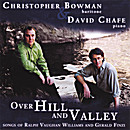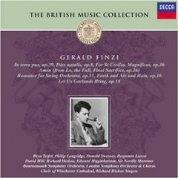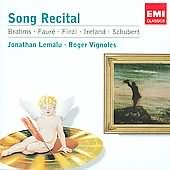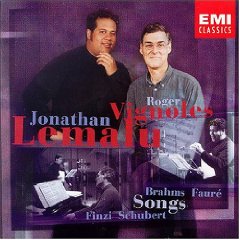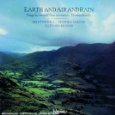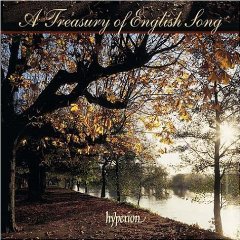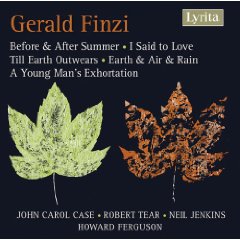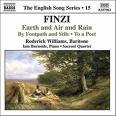In a Churchyard
Poet: Thomas Hardy
Date of poem: undated
Publication date: 1917
Publisher:
Collection: Moments of Vision
History of Poem:
Poem
While Drawing in a Churchyard |
||
|---|---|---|
Finzi's title: In A Churchyard |
||
| 1 | 'It is sad that so many of worth, | |
| 2 | Still in the flesh,' soughed the yew, | |
| 3 | 'Misjudge their lot whom kindly earth | |
| 4 | Secludes from view. | |
| 5 | 'They ride their diurnal round | |
| 6 | Each day-span's sum of hours | |
| 7 | In peerless ease, without jolt or bound | |
| 8 | Or ache like ours. | |
| 9 | 'If the living could but hear | |
| 10 | What is heard by my roots as they creep | |
| 11 | Round the restful flock, and the things said there, | |
| 12 | No one would weep.' | |
| 13 | ' "Now set among the wise," | |
| 14 | They say: "Enlarged in scope, | |
| 15 | That no God trumpet us to rise | |
| 16 | We truly hope." ' | |
| 17 | I listened to his strange tale | |
| 18 | In the mood that stillness brings, | |
| 19 | And I grew to accept as the day wore pale | |
| 20 | That show of things. | |
(Hardy, 536) |
||
Content/Meaning of the Poem:
Speaker:
Setting:
Purpose:
Idea or theme:
Style:
Form:
Synthesis:
Published comments about the poem:
✦✼✦✼✦✼✦✼✦✼✦✼✦✼✦✼✦✼✦✼✦✼✦✼✦✼✦✼✦✼✦✼✦✼✦
✦✼✦✼✦✼✦✼✦✼✦✼✦✼✦✼✦✼✦✼✦✼✦✼✦✼✦✼✦✼✦✼✦✼✦
Musical Analysis
Composition date:
Publication date:
Publisher: Boosey & Hawkes - Distributed by Hal Leonard Corporation
Tonality:
Transposition:
Duration:
Meter:
Tempo:
Form:
Rhythm:
Melody:
Texture:
Vocal Range:
Tessitura:
Dynamic Range:
Accompaniment:
Published comments about the music:
Pedagogical Considerations for Voice Students and Instructors:
✦✼✦✼✦✼✦✼✦✼✦✼✦✼✦✼✦✼✦✼✦✼✦✼✦✼✦✼✦✼✦✼✦✼✦
✦✼✦✼✦✼✦✼✦✼✦✼✦✼✦✼✦✼✦✼✦✼✦✼✦✼✦✼✦✼✦✼✦✼✦
| Pitch Analysis | ||||||
|---|---|---|---|---|---|---|
| pitch | stanza 1 |
stanza 2 |
stanza 3 |
stanza 4 |
total | |
highest |
A |
|||||
G |
||||||
F |
||||||
E |
||||||
D |
||||||
middle C |
||||||
B |
||||||
A |
||||||
G |
||||||
F |
||||||
lowest |
E |
|||||
| Rhythm Duration Analysis of Vocal Line | |||||
|---|---|---|---|---|---|
| stanza 1 | stanza 2 | stanza 3 | stanza 4 | total | |
16th note |
|||||
8th note |
|||||
dotted 8th |
|||||
quarter note |
|||||
dotted quarter |
|||||
triplet |
|||||
half note |
|||||
dotted half |
|||||
stanza total |
|||||
✦✼✦✼✦✼✦✼✦✼✦✼✦✼✦✼✦✼✦✼✦✼✦✼✦✼✦✼✦✼✦✼✦✼✦
Audio Recordings
Over Hill and Valley: Songs of Ralph Vaughan Williams and Gerald Finzi |
|
|
|
The British Music Collection: Gerald Finzi |
|
|
|
Song Recital |
|
|
|
Songs: Brahms - Faure - Finzi - Schubert |
|
|
|
The Songs of Gerald Finzi to Words by Thomas Hardy
|
|
|
|
A Treasury of English Song |
|
|
|
Gerald Finzi |
|
|
|
The English Song Series - 15 |
|
|
|
✦✼✦✼✦✼✦✼✦✼✦✼✦✼✦✼✦✼✦✼✦✼✦✼✦✼✦✼✦✼✦✼✦✼✦
The following is an analysis of In a Churchyard by Gerhardus Daniël Van der Watt. Dr. Van der Watt extended permission to post this excerpt from his dissertation on October 8th, 2010. His dissertation dated November 1996, is entitled:
The Songs of Gerald Finzi (1901-1956) To Poems by Thomas Hardy
This excerpt comes from Volume II and begins on page 239 and concludes on page 248. To view the methodology used within Dr. Van der Watt's dissertation please refer to: Methodology - Van der Watt.
1. Poet
Specific background concerning poem:
The poem (undated) comes from Moments of Vision (1917). It contains some aspects of Hardy's attitude to life and a brief reference to his scepticism towards the supernatural aspects of religion. The hope that the "restful flock" expresses that no final trumpet from God would ever disturb their rest, certainly questions the omnipotence of God if not his existence. It reminds of the haunting, pre-war poem, "Channel Firing" (also form Moments of Vision) in which Hardy's God says the following:
"It will be warmer when / I blow the trumpet (if indeed / I ever do; for you are men, / And rest eternal sorely need)."
Hardy's "religiousness consists largely of his struggle to resist meaninglessness, and ...to reject a concomitant humanism without a foundation in the human heart." (Seymour-Smith, 620)
The notion that the dead are better off than the living, especially if they will not be disturbed by a resurrection, may have been shocking to the orthodox clergy, but was certainly expressing the disillusionment with God and humanity, during the First World War, in a strikingly novel way.
2. Poem
While Drawing in a Churchyard |
||
|---|---|---|
| 1 | 'It is sad that so many of worth, | a |
| 2 | Still in the flesh,' soughed the yew, | b |
| 3 | 'Misjudge their lot whom kindly earth | a |
| 4 | Secludes from view. | b |
| 5 | 'They ride their diurnal round | c |
| 6 | Each day-span's sum of hours | d |
| 7 | In peerless ease, without jolt or bound | c |
| 8 | Or ache like ours. | d |
| 9 | 'If the living could but hear | e |
| 10 | What is heard by my roots as they creep | f |
| 11 | Round the restful flock, and the things said there, | e |
| 12 | No one would weep.' | f |
| 13 | ' "Now set among the wise," | g |
| 14 | They say: "Enlarged in scope, | h |
| 15 | That no God trumpet us to rise | g |
| 16 | We truly hope." ' | h |
| 17 | I listened to his strange tale | i |
| 18 | In the mood that stillness brings, | j |
| 19 | And I grew to accept as the day wore pale | i |
| 20 | That show of things. | j |
(Hardy, 536) |
||
There are three characters present in the poem: the yew tree (symbolizing nature equating itself with the living), the "restful flock" (representing the deceased) and the persona (who represents the individual), in all probability, Hardy. the tree does most of the talking (stanzas 1-3), quotes the deceased with whom it has intimate contact through its roots (stanza 4) and the persona reacts silently, by accepting the point-of-view presented to him by the tree.
In stanza 1 the tree (nature) bemoans the fact that many of the worthy living (sensible, sensitive human beings) are mistaken in their view of earthly life and what happens to the dead. It explains that the dead spend their days in "peerless ease" unlike the ups and downs of its own and human life. In stanza 3 the tree reminds the listener (the persona and reader) that it has the advantage of intimate contact with the buried deceased in the graveyard and that if the living could but hear what is said underground, they would not pity the dead or bewail their own approaching death. In stanza 4 the tree quotes the deceased: they are among the wise and with the broader vision they now have, they fervently hope that no resurrection of the dead will ever take place. The implication is that they would not exchange the rest they experience now, for eternal life, if this will resemble in any way, the chequered earthly existence of a human being. The scene is really only set in the final stanza. The persona experiences a quiet almost peaceful mood while the day is slowly fading and in this pondering state of mind, he gradually accepts the point of view expressed by the deceased, in the words of the tree. nature has convinced the persona, of the powerful argument of the deceased, that it is better to be dead than to suffer the blows and disappointments of the living and that it would be better to stay at peace than to be resurrected into eternal life.
The poetic style is that of philosophical musing, not presenting a systematic philosophy of life in poetic form, but a "moment of vision", a questioning attitude, a poet struggling to overcome meaninglessness in an apparently "indifferent century". (Hardy 1914/Gibbon 1976:305) There is a pastoral element in the poem: the personification of nature in conversation with man.
The poem consists of five quatrains with a rounded rhyme scheme: abab cdcd etc. The metre is substantially iambic with a large number of dactylic lines (l. 1-2, 9-10, 12, 17-19). There is one significant spondaic instance, line 15, "no God trumpet", a clear climactic moment as far as the semantic structure is concerned, here reinforced by a metric emphasis.
Death is not what it seems to the living. If they, the living, could hear what is experienced by the dead, now "set among the wise" and "enlarged in scope", they would see death as a lasting repose. The one thing that dead hope is that there will be no final trumpet to disturb their rest. The style and content of the poem, is matched with a slow shift in mood from Gothic enquiry to a quiet understanding and acceptance. These subtleties are achieved through economic use of language and imagery especially through the use of the extended metaphor of the yew tree.
Setting
1. Timbre
VOICE TYPE/RANGE
The poem is set for baritone and the range is a perfect eleventh from the second A below middle C.
The piano accompaniment ranges over four octaves from the first D flat above middle C downward. The lower register is favoured with the right hand notated in the bass clef for more than half the duration of the song (54% of the bars). A dark timbre is employed, especially in the music accompanying stanza 3 (b. 34-42). The image of the tree's roots winding around below the surface of the graveyard is aptly portrayed.
There are no indications of pedalling while the pedal would certainly be vital in achieving the right atmosphere, especially with the unusually long pedal notes (b. 0-8, 11-19, 64-74). Staccato indications are restricted to a motif which occurs only in the prelude and postlude (b. 2, 3, 7, 71, 72). Portamento accents are more numerous (b. 20, 48, 49, 55, 56, 57, 64, 65, 69, 71, 72) and are used mildly to highlight a specific note or chord. Stronger accents occur in a localized area: bar 50 (>) and 42-43, 50-51 (^). The concentration of accents of varying degrees in bars 48-52, coincides with the poetic climax, "enlarged in scope / That no God trumpet us to rise".
The piano accompaniment captures vividly the marginally changing atmosphere:
- The prelude and first stanza (b. 0-12) are dark, serious and gloomy
- The interlude and first three lines of the second stanza (b. 13-27) are a little friendlier, with more movement
- The last line of stanza 2 (b. 28-34) is troubled and "aching"
- the first three lines of stanza 3 are dark, sinister and even macabre
- The last line of stanza 3 and the whole of stanza 4 (b. 34-54), is more positive, almost heroic (the key of D flat major established). The only sombre reference is that made to the unwelcome final "trumpet"
- Stanza 5 (b. 55-65) has a pastoral atmosphere and change to D major evokes a pleasantness as though a clear insight has been gained
- The postlude (b. 66-74) returns to the opening material and atmosphere, now in b minor, a third lower, making it even more serious and gloomy.
2. Duration
METRE
The dactylic metre of the text has resulted in the largely compound duple metre in which the song starts while the iambic metre is reflected in the simple quadruple and duple metres. All metric variation are listed below:

Most prominent metre
Compound duple and triple metres account for 69% of the bars and are the most prominent while the simple metres (duple and quadruple) account for 31% of the bars.
Rhythmic motifs
Four rhythmic motifs for the compound duple sections establish themselves firmly as musical, binding elements: motif 1, consisting of a crotchet and quaver occurs a total of 42 times vocally (b. 8, 9(2), 10, 11, 18, 19, 24, 26, 27, 39, 40 and pianistically b. 7(2), 8(3), 9(2), 11, 12, 13, 14(2), 15(2), 16(2), 17(2), 18(2), 19(2), 24(2), 25(2), 26(2), 27(2)), motif 2, consisting of three quavers occurs a total of 35 times (vocally b. 6, 18, 35, 36, 37, 38, 41 and pianistically b. 2, 6(2), 20, 21, 22, 30, 31, 32 33(2), 34(2), 35(2), 36(2), 37(4), 38(4), 67, 69, 71); motif 3, consisting of two dotted crotchets occurs a total of 23 times (vocally b. 20, 21 and pianistically b. 1, 5, 6, 7, 9, 11, 20-31, 35, 36, 41); motif 4, consisting of a dotted quaver, semi-quaver and quaver occurs a total 11 times (vocally b. 5(2) and pianistically b. 1(2), 5(4), 68, 70(2)).
In the simple duple section a rhythmically active motif consisting of four semi-quavers (motif 5) becomes prominent in the piano part (b. 55(2), 56(2), 57(3), 58(2), 59(2), 60(2), 612)). This motif is in strong contrast to the preceding lists and helps to change the atmosphere considerably.
Where rhythmic motifs are so numerous, the ones occurring less obviously also gain importance through their intentional lack of recurrence. Such a motif (dotted semi-quaver, demi-semi-quaver and crotchet) is found four times in the prelude (b. 3(2) and 7(2)) and twice in the postlude (b. 72(2)). It also carries melodic significance in the bass (a major 7th interval) and foreshadows the sombre references to the deceased. Another such motif is the one which occurs twice in bars 50-51 associated with the trumpet-call on judgement day. Finally, the motif consisting of a crotchet and two quavers which occurs in the right hand piano part of bars 55-58 and 62-63 with its initial melodic consideration of a perfect 5th up and down, suggests a certain innocence or pleasantness associated with stanza 5.
Rhythmic activity vs. Rhythmic stagnation

Rhythmically perceptive, erroneous and interesting settings
The following words have been perceptively dealt with rhythmically:
The placing of "That" on a beat that is strong but of relatively short value in bar 64, closely follows the textual metre and placement (at the beginning of a line). The dotted crotchet on the word "of" in bar 21 seems unnecessarily long for a word of mere syntactic value, devoid of real semantic significance.
Lengthening of voiced consonants
The following words containing voiced consonants have been rhythmically prolonged in order to make the words more singable:
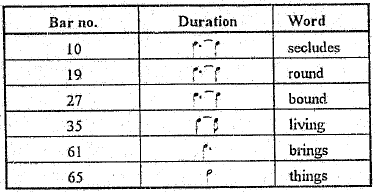
The tempo indication is Tempo I ![]() and a number of deviations on this occur, which are listed in the table below:
and a number of deviations on this occur, which are listed in the table below:

All tempo changes are functional in terms of musical considerations, or supportive of the textual meaning.
3. Pitch
An interval analysis of the vocal line is represented in the following table:
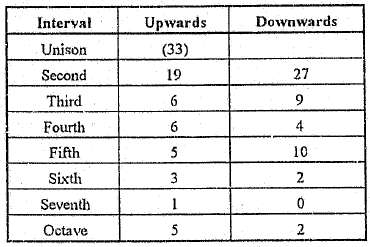
There are 33 repeated pitches (25% of the total number of intervals), 45 (34%) rising intervals and 54 (41%) falling intervals. The substantially higher occurrence of falling intervals is an important contributor to the over-all solemn atmosphere of the song. There are 94 (or 71%) smaller intervals (thirds and smaller) and 38 (or 29%) larger intervals (fourths and larger). These figures are testimony to Finzi's sympathy for the limitations of the human voice. Larger intervals are important in such a context for they are not randomly used, but associated with certain textual meanings. A list of specific settings follows:
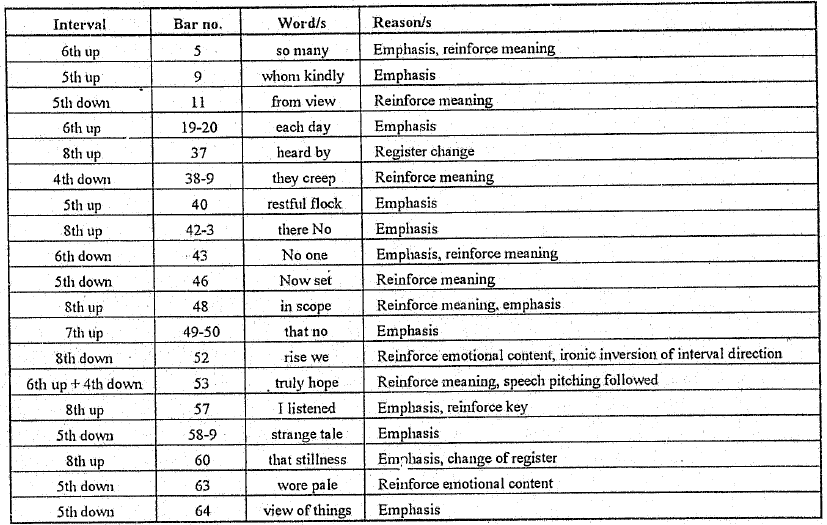
The list of words and concepts in this table is also a list of the most important words in the poem and thus the treatment with larger intervals is appropriate.
Melodic curve
A melodic curve of the vocal line is represented below. Words and phrases from the text are indicated to show the relationship between the melodic curve and the textual meaning.
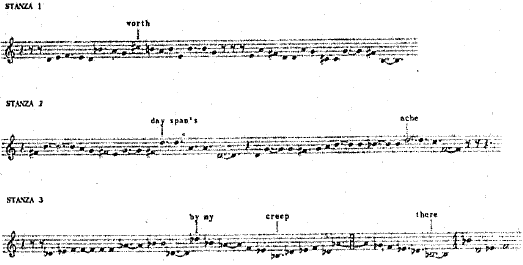
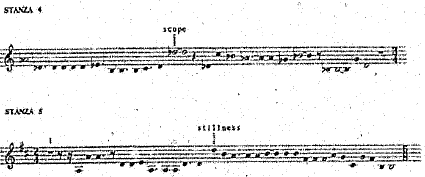
Climaxes
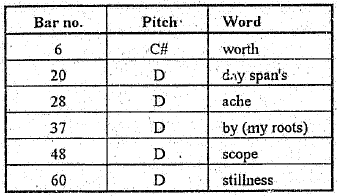
The highest pitches (D) with the words "day span" and "stillness" are not significant climaxes although they are relatively important in their smaller contexts. The real climax of the song coincides not with a melodic moment but a harmonic and dynamic one: bars 49-51 with the text "That no God us to rise".
Phrase lengths

The song starts in d minor and then modulates in the compass of a major third interval to b minor, b flat minor, D flat major, B flat major, D major and b minor, an interesting closely knitted scheme in all cases directly related to the subtle changes of mood in the text.

Chromaticism
There are a number of instances of chromaticism. On the word "ache" a C major triad, II in b flat minor and an implied D flat major triad (with the F missing), III in b flat minor, are superimposed on one another. The result is very effective in the immediate context. The trumpet-call in bars 50 and 51 employs a similar technique (D flat-F-A flat imposed on E flat-(G)-B flat; C-E flat-G flat imposed on F A (C)). The irony of the unwelcome and unwanted final trumpet, is set here with stark and wry realism. Finally, a Neapolitan chord of sorts (a lowered step two, E flat-G-B flat in D major) is used in an effective modulation form B flat major to D major, an instantaneous change of mood, as sudden as in the poem: " 'We truly hope'(underground) / I listened (out in the open)".
HARMONY AND COUNTERPOINT
The harmony, though tonal, has certain chromatic features, which has just been referred to.
Non-harmonic tones

Harmonic devices

Harmonic accents
A number of harmonic accents are listed below:
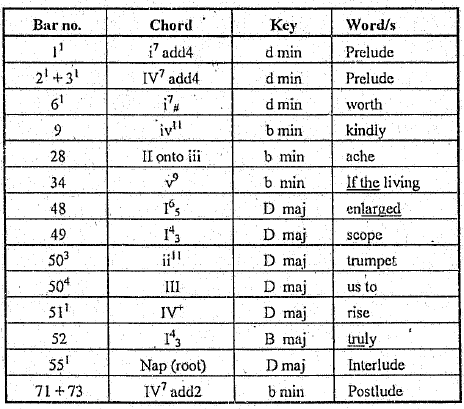
These words, considering the context in which they occur, can be considered harmonic accents.
Counterpoint
A small number of varied imitations of vocal material occur in the piano part:
Loudness variation is given in the following summary:
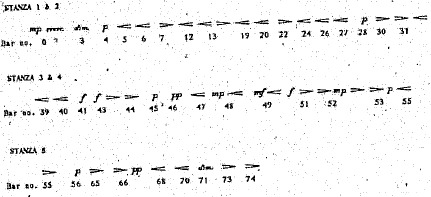
FREQUENCY
There are 51 dynamic indications (or indications in 69% of the bars). There are no separate indications for the voice. This implies that the indications for the piano are also valid for the voice.
RANGE
the lowest level of indication pp, occurs in bar 46 with the text, "Now set among the wise" and bar 66 at the Tempo I, indication. The highest level of indication is f which occurs in two places: bars 41-43 with the text, "...flock, and the things said there / No one would weep", stressing the importance of the text; also bars 49-51 with the text, "That no God trumpet us to rise", the real climax of the song, s discussed earlier.
VARIETY
Indications used are:
DYNAMIC ACCENTS
Dynamic accents occur only with the two above mentioned climaxes in bars 42-43 and 50-51.
The density varies loosely between three and eight parts including both piano and voice. The thickness of the piano part is represented in the following table:
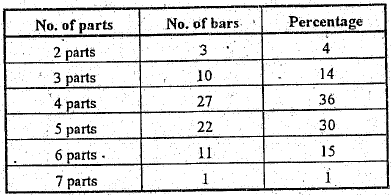
The four- and five-part textures account for most of the bars (66%). The tree bars of two-part texture are of some interest. In bars 37-38 the piano plays in thirds more than an octave below middle C. It is first of all sensible pianistic technique not to have too full a texture in this register, unless for a specific purpose and secondly, the text refers to the tree's roots and their creeping around where the dead are, thus, the texture and register are most appropriate. The other depletion of texture is found in bar 61. Here the pleasant atmosphere of the preceding bars slowly gives way to the darker and more serious mood of the Tempo I section. The decrease in voice parts anticipates the change of mood.
the structure of the song is represented in the following table:

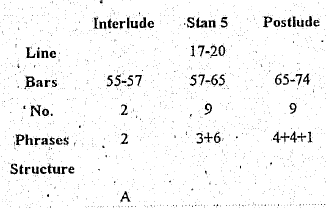
The song is largely through-composed but has a strong enough reference back to the opening to be referred to also as being in ternary form.
7. Mood and atmosphere
There is a gradual change of mood in the song, as has been shown throughout the analysis. The musical elements support one another to achieve this development. The most striking change of mood is that in bar 46 where the deceased are quoted. The major key, quiet dynamic level, textural density, rhythmic stagnation and low voice register have a calming, positive and almost heroic effect. It is ironic because one would expect the contrary from a quotation from the dead. Knowing, however, that the deceased really are relating Hardy's understanding of death and scepticism about resurrection, the composer purposely chose to make a positive statement, due to his sympathy with the poet's view.
General comment on style
The vocal treatment is very sympathetic with some eight octave leaps which serve as register changes and reinforcement of textual meaning. The piano accompaniment is restrained in use and restricted to the particular sonority most suitable for portraying the meaning of the text.
Unpublished Analysis Excerpts
The following is an analysis of In A Churchyard by Curtis Alan Scheib. Dr. Scheib extended permission to post this excerpt from his dissertation on February 17th, 2012. His dissertation dated 1999, is entitled:
Gerald Finzi's Songs For Baritone On Texts By Thomas Hardy: An Historical And Literary Analysis And Its Effect On Their Interpretation
This excerpt begins on page forty-nine and concludes on page fifty.
In A Churchyard |
||
|---|---|---|
| 'It is sad that so many of worth, | ||
| Still in the flesh,' soughed the yew, | ||
| 'Misjudge their lot whom kindly earth | ||
| Secludes from view. | ||
| 'They ride their diurnal round | ||
| Each day-span's sum of hours | ||
| In peerless ease, without jolt or bound | ||
| Or ache like ours. | ||
| 'If the living could but hear | ||
| What is heard by my roots as they creep | ||
| Round the restful flock, and the things said there, | ||
| No one would weep.' | ||
| ' "Now set among the wise," | ||
| They say: "Enlarged in scope, | ||
| That no God trumpet us to rise | ||
| We truly hope." ' | ||
| I listened to his strange tale | ||
| In the mood that stillness brings, | ||
| And I grew to accept as the day wore pale | ||
| That show of things. | ||
(Hardy, 536) |
||
Here the poet has entered a churchyard were the yew tree councils him to find a peaceful acceptance of death. It is an atheistic acceptance that is arrived at however, significant in view of the philosophies of both poet and composer. Finzi gives the song the subtitle, Song of the Yew Tree, and begins in D minor with a creeping figure in the bass of the piano that becomes the vocal line in the next measure (example 15).
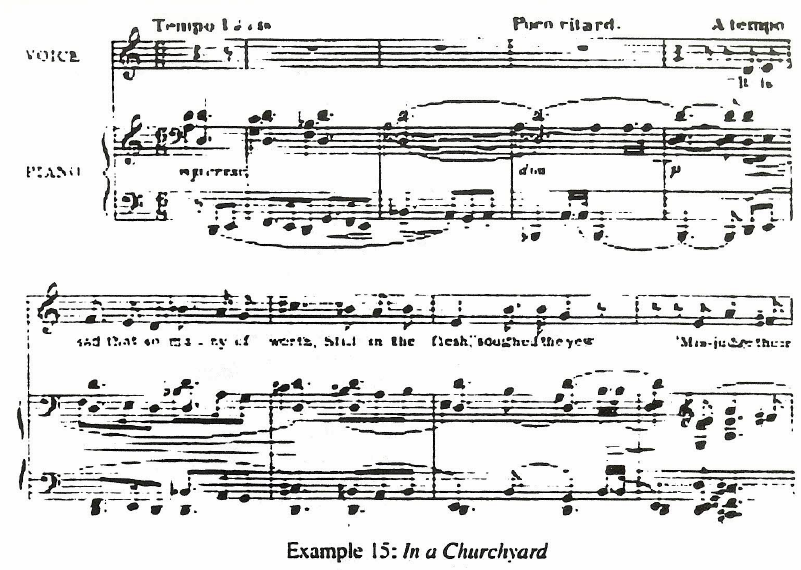
The yew's council proceeds in a rather low and murky sonority in the piano with a good deal of chromatic harmony and a descent to Db Major, all to illustrate the place of the dead below ground. As the acceptance of the "strange tale" comes, there is a phrygian cadence and a move to D Major, accompanied by a more lyrical section with an undulating accompanimental figure. This is followed by a final ritornello in the piano in the original D minor, closing in B minor as the final acceptance is reached.
The preceding was an analysis of In A Churchyard by Curtis Alan Scheib. Dr. Scheib extended permission to post this excerpt from his dissertation on February 17th, 2012. His dissertation dated 1999, is entitled:
Gerald Finzi's Songs For Baritone On Texts By Thomas Hardy: An Historical And Literary Analysis And Its Effect On Their Interpretation
The excerpt began on page forty-nine and concluded on page fifty.

